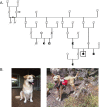Genetic Panel Screening of Nearly 100 Mutations Reveals New Insights into the Breed Distribution of Risk Variants for Canine Hereditary Disorders
- PMID: 27525650
- PMCID: PMC4985128
- DOI: 10.1371/journal.pone.0161005
Genetic Panel Screening of Nearly 100 Mutations Reveals New Insights into the Breed Distribution of Risk Variants for Canine Hereditary Disorders
Abstract
Background: The growing number of identified genetic disease risk variants across dog breeds challenges the current state-of-the-art of population screening, veterinary molecular diagnostics, and genetic counseling. Multiplex screening of such variants is now technologically feasible, but its practical potential as a supportive tool for canine breeding, disease diagnostics, pet care, and genetics research is still unexplored.
Results: To demonstrate the utility of comprehensive genetic panel screening, we tested nearly 7000 dogs representing around 230 breeds for 93 disease-associated variants using a custom-designed genotyping microarray (the MyDogDNA® panel test). In addition to known breed disease-associated mutations, we discovered 15 risk variants in a total of 34 breeds in which their presence was previously undocumented. We followed up on seven of these genetic findings to demonstrate their clinical relevance. We report additional breeds harboring variants causing factor VII deficiency, hyperuricosuria, lens luxation, von Willebrand's disease, multifocal retinopathy, multidrug resistance, and rod-cone dysplasia. Moreover, we provide plausible molecular explanations for chondrodysplasia in the Chinook, cerebellar ataxia in the Norrbottenspitz, and familiar nephropathy in the Welsh Springer Spaniel.
Conclusions: These practical examples illustrate how genetic panel screening represents a comprehensive, efficient and powerful diagnostic and research discovery tool with a range of applications in veterinary care, disease research, and breeding. We conclude that several known disease alleles are more widespread across different breeds than previously recognized. However, careful follow up studies of any unexpected discoveries are essential to establish genotype-phenotype correlations, as is readiness to provide genetic counseling on their implications for the dog and its breed.
Conflict of interest statement
Figures




References
-
- Faculty of Veterinary Science, University of Sydney. Online Mendelian Inheritance in Animals, OMIA; Available: http://omia.angis.org.au/.
-
- PennGen—Section of Medical Genetics, School of Veterinary Medicine, University of Pennsylvania. Listing of Canine and Feline Hereditary Disease (DNA) Testing Laboratories. Available: http://research.vet.upenn.edu/penngen/AvailableTests/TestsAvailableatLab....
MeSH terms
Substances
Grants and funding
LinkOut - more resources
Full Text Sources
Other Literature Sources
Medical

